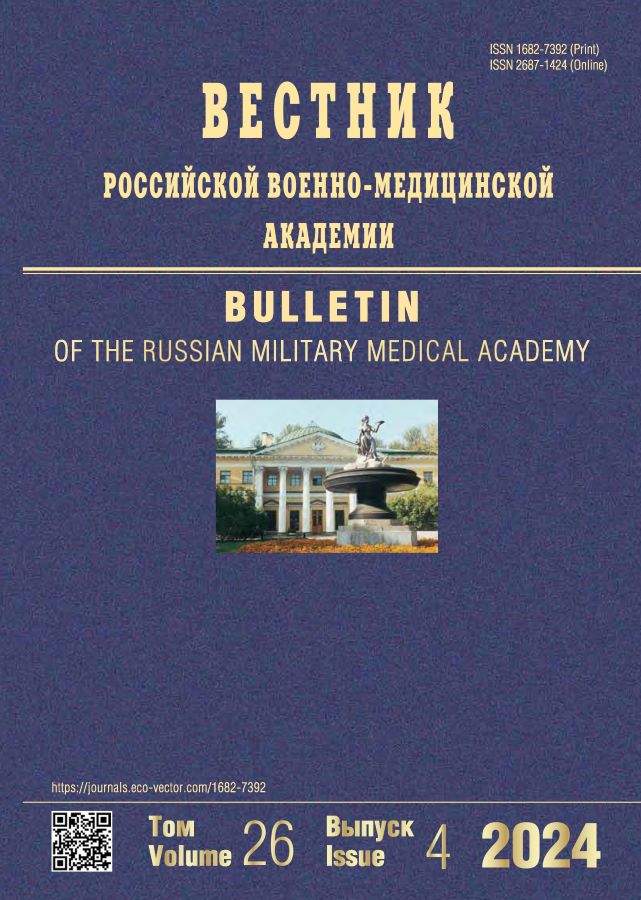Comparative analysis of the hemostatic effect of systemic recombinant Factor VIIa and exogenous fibrin monomer in an experimental model of heparinization and posttraumatic blood loss
- Authors: Vdovin V.M.1, Shakhmatov I.I.1, Lycheva N.A.1, Subbotin E.А.1, Momot A.P.1,2
-
Affiliations:
- Altai State Medical University
- National Medical Research Center of Hematology
- Issue: Vol 26, No 4 (2024)
- Pages: 569-578
- Section: Original Study Article
- Submitted: 12.08.2024
- Accepted: 01.10.2024
- Published: 24.12.2024
- URL: https://journals.eco-vector.com/1682-7392/article/view/635130
- DOI: https://doi.org/10.17816/brmma635130
- ID: 635130
Cite item
Abstract
This article presents the results of a study of the systemic hemostatic action of recombinant Factor VIIa in a rabbit model of heparin-induced coagulopathy and posttraumatic bleeding, compared to the administration of exogenous fibrin monomer. The coagulopathy was induced by a single intravenous injection of unfractionated heparin at a dose of 150 IU/kg 15 minutes before injury. Recombinant Factor VIIa (270 μg/kg) or fibrin monomer (0.25 mg/kg) was used as systemic hemostatic agents. One hour after administrating the agents, a standardized liver injury was inflicted, followed by an assessment of blood loss characteristics. Using rotational thromboelastometry and coagulation tests, animal venous blood was analyzed for coagulation time, alpha angle, clot formation time, maximum clot firmness, clot density at 10 minutes, activated partial thromboplastin time, prothrombin time, thrombin time, and fibrinogen concentration. Pharmacologically induced coagulopathy resulted in shifts to a hypocoagulable profile, associated with severe blood loss (1.9 times, p = 0.028) and high animal mortality (26.1%, p = 0.022) compared to the control group. Preventive administration of fibrin monomer or recombinant Factor VIIa reduced posttraumatic blood loss (by 5.4 times, p < 0.001, and by 2.1 times, p = 0.009, respectively), resulting in a decrease in mortality rates. However, the administration of these agents did not correct the hypocoagulable profile as observed in thromboelastometry and coagulation tests. These data demonstrate the hemostatic effect of both agents, with a more pronounced effect after fibrin monomer administration, and suggest potential use of low doses of fibrin monomer in trauma-related hemorrhage. The mechanism of action of fibrin monomer requires further investigation. Therefore, fibrin monomer, a fibrinogen derivative obtained from blood plasma, could be a valuable candidate for managing wound bleeding in addition to recommended systemic hemostatics.
Full Text
About the authors
Vyacheslav M. Vdovin
Altai State Medical University
Email: erytrab@gmail.com
ORCID iD: 0000-0002-4606-3627
SPIN-code: 5885-4504
MD, Cand. Sci. (Medicine), associate professor
Russian Federation, BarnaulIgor I. Shakhmatov
Altai State Medical University
Email: iish59@yandex.ru
ORCID iD: 0000-0002-0979-8560
SPIN-code: 1574-4980
MD, Dr. Sci. (Medicine), professor
Russian Federation, BarnaulNatalya A. Lycheva
Altai State Medical University
Email: natalia.lycheva@yandex.ru
ORCID iD: 0000-0002-5842-5728
SPIN-code: 7646-0875
Cand. Sci. (Biology), assistant professor
Russian Federation, BarnaulEvgeniy А. Subbotin
Altai State Medical University
Email: subbotin70@bk.ru
ORCID iD: 0000-0001-5850-0233
SPIN-code: 7244-5998
MD, Cand. Sci. (Medicine), associate professor
Russian Federation, BarnaulAndrey P. Momot
Altai State Medical University; National Medical Research Center of Hematology
Author for correspondence.
Email: xyzan@yandex.ru
ORCID iD: 0000-0002-8413-5484
SPIN-code: 8464-9030
MD, Dr. Sci. (Medicine), professor, Altai Branch
Russian Federation, Barnaul; BarnaulReferences
- Cap A, Hunt BJ. The pathogenesis of traumatic coagulopathy. Anaesthesia. 2015;70(Suppl. 1):96–101. doi: 10.1111/anae.12914
- Heckbert SR, Vedder NB, Hoffman W, et al. Outcome after hemorrhagic shock in trauma patients. J Trauma. 1998;45(3): 545–549. doi: 10.1097/00005373-199809000-00022
- Karkouki K, Wijeysundera DN, Yau TM, et al. The independent association of massive blood loss with mortality in cardiac surgery. Transfusion. 2004;44(10):1453–1462. doi: 10.1111/j.1537-2995.2004.04144.x
- Lloyd L, Jenkins PV, Bell SF, et al. Acute obstetric coagulopathy during postpartum hemorrhage is caused by hyperfibrinolysis and dysfibrinogenemia: an observational cohort study. J Thromb Haemost. 2023;21(4):862–879. doi: 10.1016/j.jtha.2022.11.036
- Ageno W, Donadini M. Breadth of complications of long-term oral anticoagulant care. Hematology Am Soc Hematol Educ Program. 2018;30(1):432–438. doi: 10.1182/asheducation-2018.1.432
- Pohlman TH, Fecher AM, Arreola-Garcia C. Optimizing transfusion strategies in damage control resuscitation: current insights. J Blood Med. 2018;9:117–133. doi: 10.2147/JBM.S165394
- Melnik AA. Mechanism of action of haemostatic drugs. Medical and Pharmacy News. 2017;622(10):1–17. (In Russ.)
- Rossaint R, Afshari A, Bouillon B, et al. The European guideline on management of major bleeding and coagulopathy following trauma: sixth edition. Crit Care. 2023;27(1):80. doi: 10.1186/s13054-023-04327-7
- Köhler M. Thrombogenicity of prothrombin complex concentrates. Thromb Res. 1999;95(4 Suppl 1):S13–S17. doi: 10.1016/s0049-3848(99)00079-1
- Hoffman M, Monroe DM. Coagulation 2006: a modern view of hemostasis. Hematol Oncol Clin North Am. 2007;21(1):1–11. doi: 10.1016/j.hoc.2006.11.004
- Butylin AA, Panteleev MA, Ataullahanov FI. Spatial dynamics of blood coagulation. Rossijskij Himicheskij Zhurnal. 2007;51(1):45–50. (In Russ.) EDN: HZYZAN
- Momot AP, Vdovin VM, Momot DA, et al. New opportunities to reduce blood loss with systemic administration of low-dose fibrin monomer. Clinical Physiology of Circulation. 2019;16(4):267–73. (In Russ.) EDN: JFCAAS doi: 10.24022/1814-6910-2019-16-4-267-273
- Zhiburt EB, Madzaev SR, Klyueva EA. Recombinant activated factor VII in stopping bleeding on the background of antithrombotic therapy. Effective pharmacotherapy. Anaesthesiology and reanimatology. 2014;(1):12–18. (In Russ.)
- Nekhaev IV, Prikhodchenko AO, Zhuzhginova OV, et al. Recombinant factor VIIA in intensive care. Russian Journal of Hematology and Transfusiology. 2015;60(2):32–39. (In Russ.) EDN: TXKIRH
- Khabriev RU. Guidelines for experimental (preclinical) study of new pharmacological substances. 2-nd ed. Moscow. Meditsina; 2005. 826 р. (In Russ.) EDN: QCIIOB
- Lisman T, Groot PhGD Mechanism of action of recombinant factor VIIa. J Thromb Haemost. 2003;1(6):1138–1139. doi: 10.1046/j.1538-7836.2003.00225.x
- Das K, Keshava S, Ansari SA, et al. Factor VIIa induces extracellular vesicles from the endothelium: a potential mechanism for its hemostatic effect. Blood. 2021;137(24):3428–3442. doi: 10.1182/blood.2020008417
- Momot AP, Vdovin VM, Orekhov DA, et al. Prevention of massive intraoperative bleedings associated with heparin with the systemic use of fibrin monomer in the experiment. Patological Physiology and Experimental Therapy. 2019;63(4):48–55. EDN: NXWNDC doi: 10.25557/0031-2991.2019.04.48-55
- Lempert АR, Belozerskaya GG, Makarov VА, et. al. Hemostatic activity of new fibrin-monomer based compound upon intravenous injection in experiment. Experimental and Clinical Pharmacology. 2018;81(11):14–17. EDN: VNUIMU doi: 10.30906/0869-2092-2018-81-11-14-17
- Vdovin VM, Momot AP, Orehov DA, et al. Influence of exogenous fibrin monomer on hemostatic potential and formation of fibrin in the area of dosed liver injury in experiment. Russian Journal of Physiology. 2020;106(9):1132–1143. EDN: BYAZIN doi: 10.31857/S0869813920070092










